UK Employment Law Since 1970s & Business Formation Features
VerifiedAdded on 2023/06/08
|7
|1874
|72
Report
AI Summary
This report provides an overview of UK employment law and the fundamental features of business formation in the UK. It discusses the historical structure of UK employment law since the 1970s, examining whether it favors employers or employees, highlighting key legislation such as the Employment Rights Act 1996 and the Equality Act 2010. The report also details the essential steps and legal structures for establishing a business in the UK, including companies, partnerships, limited liability partnerships, and sole proprietorships, outlining the requirements for registration and compliance with relevant laws. The report concludes that employment law provides rights and duties to both employers and employees and assists in maintaining healthy relationships between them. Desklib provides this and similar documents to aid students in their studies.
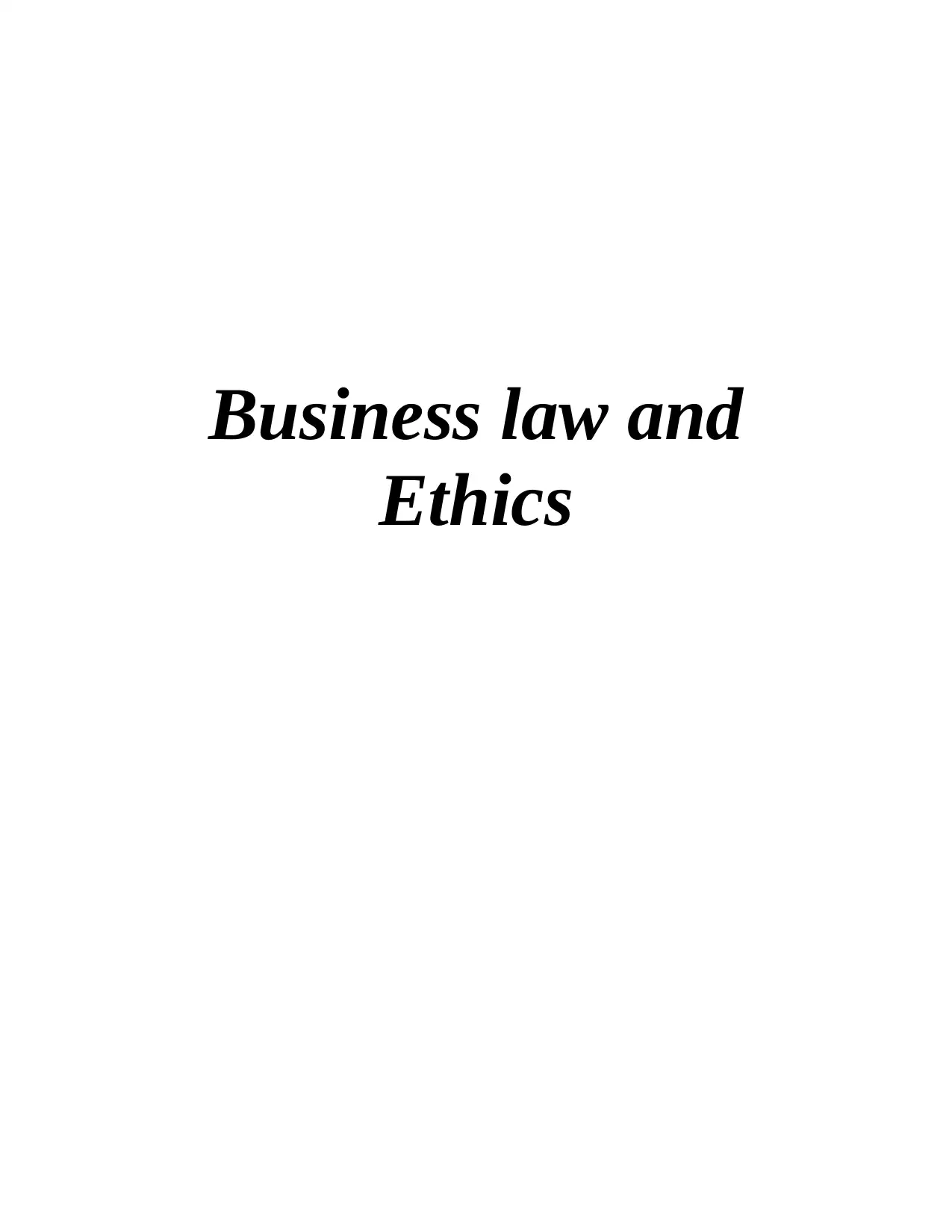
Business law and
Ethics
Ethics
Paraphrase This Document
Need a fresh take? Get an instant paraphrase of this document with our AI Paraphraser
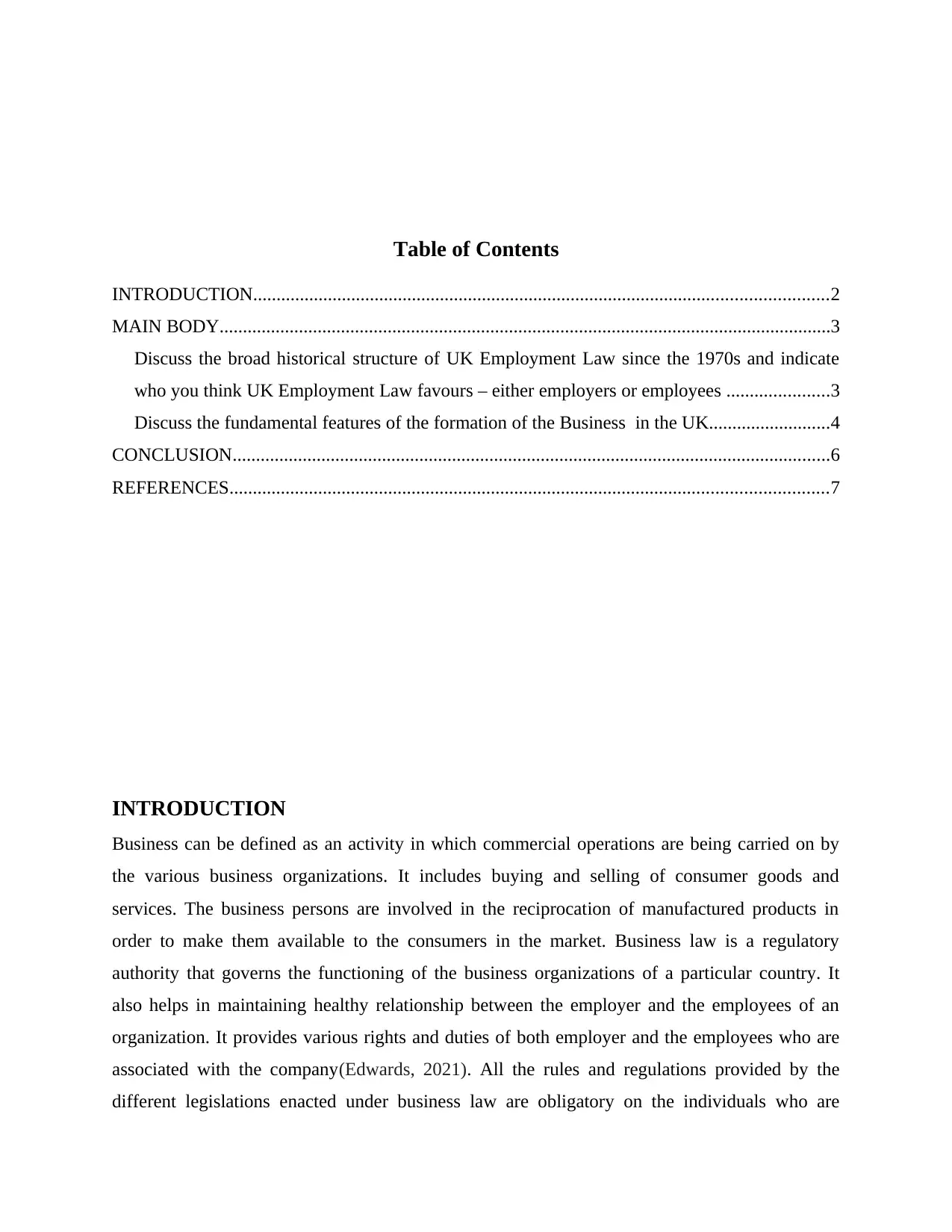
Table of Contents
INTRODUCTION...........................................................................................................................2
MAIN BODY...................................................................................................................................3
Discuss the broad historical structure of UK Employment Law since the 1970s and indicate
who you think UK Employment Law favours – either employers or employees ......................3
Discuss the fundamental features of the formation of the Business in the UK..........................4
CONCLUSION................................................................................................................................6
REFERENCES................................................................................................................................7
INTRODUCTION
Business can be defined as an activity in which commercial operations are being carried on by
the various business organizations. It includes buying and selling of consumer goods and
services. The business persons are involved in the reciprocation of manufactured products in
order to make them available to the consumers in the market. Business law is a regulatory
authority that governs the functioning of the business organizations of a particular country. It
also helps in maintaining healthy relationship between the employer and the employees of an
organization. It provides various rights and duties of both employer and the employees who are
associated with the company(Edwards, 2021). All the rules and regulations provided by the
different legislations enacted under business law are obligatory on the individuals who are
INTRODUCTION...........................................................................................................................2
MAIN BODY...................................................................................................................................3
Discuss the broad historical structure of UK Employment Law since the 1970s and indicate
who you think UK Employment Law favours – either employers or employees ......................3
Discuss the fundamental features of the formation of the Business in the UK..........................4
CONCLUSION................................................................................................................................6
REFERENCES................................................................................................................................7
INTRODUCTION
Business can be defined as an activity in which commercial operations are being carried on by
the various business organizations. It includes buying and selling of consumer goods and
services. The business persons are involved in the reciprocation of manufactured products in
order to make them available to the consumers in the market. Business law is a regulatory
authority that governs the functioning of the business organizations of a particular country. It
also helps in maintaining healthy relationship between the employer and the employees of an
organization. It provides various rights and duties of both employer and the employees who are
associated with the company(Edwards, 2021). All the rules and regulations provided by the
different legislations enacted under business law are obligatory on the individuals who are
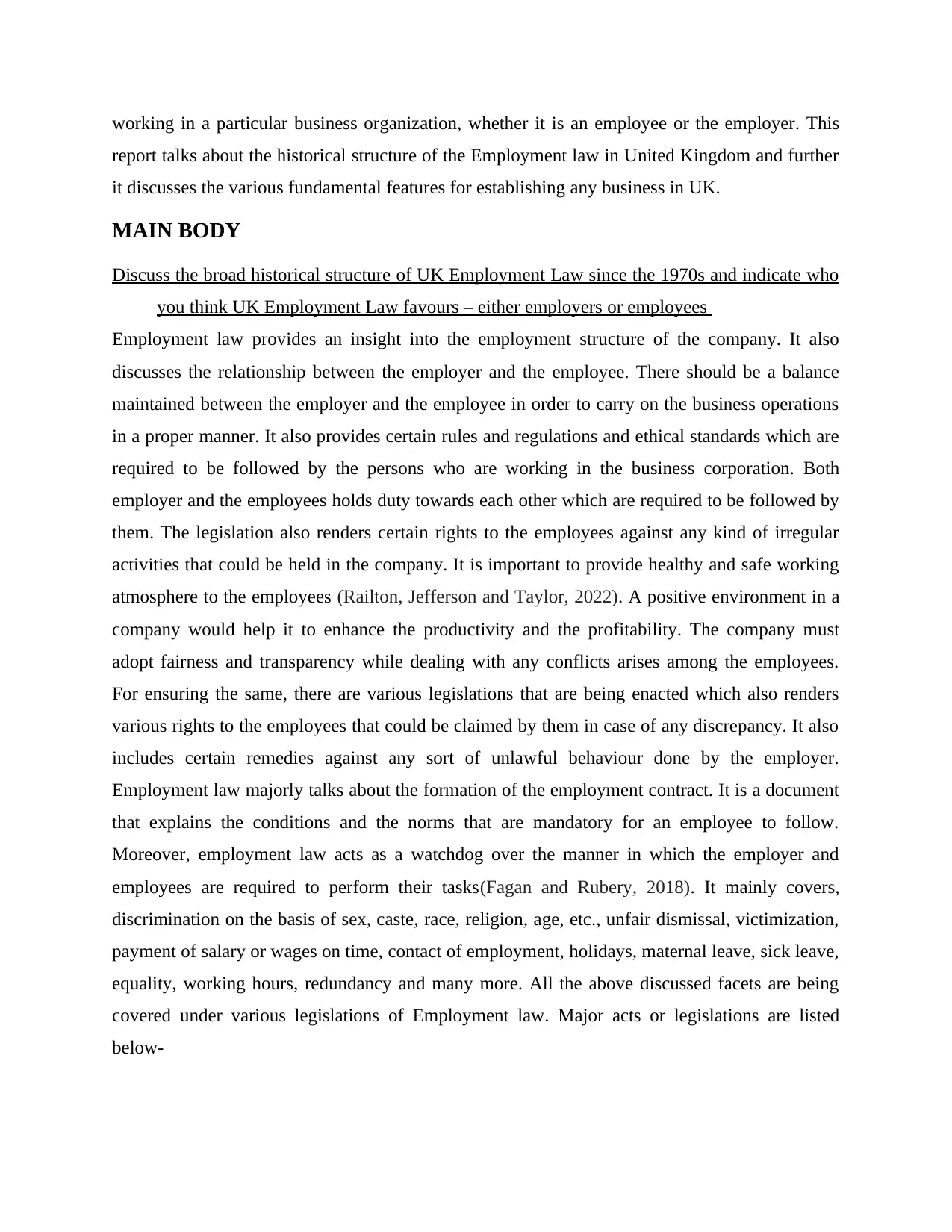
working in a particular business organization, whether it is an employee or the employer. This
report talks about the historical structure of the Employment law in United Kingdom and further
it discusses the various fundamental features for establishing any business in UK.
MAIN BODY
Discuss the broad historical structure of UK Employment Law since the 1970s and indicate who
you think UK Employment Law favours – either employers or employees
Employment law provides an insight into the employment structure of the company. It also
discusses the relationship between the employer and the employee. There should be a balance
maintained between the employer and the employee in order to carry on the business operations
in a proper manner. It also provides certain rules and regulations and ethical standards which are
required to be followed by the persons who are working in the business corporation. Both
employer and the employees holds duty towards each other which are required to be followed by
them. The legislation also renders certain rights to the employees against any kind of irregular
activities that could be held in the company. It is important to provide healthy and safe working
atmosphere to the employees (Railton, Jefferson and Taylor, 2022). A positive environment in a
company would help it to enhance the productivity and the profitability. The company must
adopt fairness and transparency while dealing with any conflicts arises among the employees.
For ensuring the same, there are various legislations that are being enacted which also renders
various rights to the employees that could be claimed by them in case of any discrepancy. It also
includes certain remedies against any sort of unlawful behaviour done by the employer.
Employment law majorly talks about the formation of the employment contract. It is a document
that explains the conditions and the norms that are mandatory for an employee to follow.
Moreover, employment law acts as a watchdog over the manner in which the employer and
employees are required to perform their tasks(Fagan and Rubery, 2018). It mainly covers,
discrimination on the basis of sex, caste, race, religion, age, etc., unfair dismissal, victimization,
payment of salary or wages on time, contact of employment, holidays, maternal leave, sick leave,
equality, working hours, redundancy and many more. All the above discussed facets are being
covered under various legislations of Employment law. Major acts or legislations are listed
below-
report talks about the historical structure of the Employment law in United Kingdom and further
it discusses the various fundamental features for establishing any business in UK.
MAIN BODY
Discuss the broad historical structure of UK Employment Law since the 1970s and indicate who
you think UK Employment Law favours – either employers or employees
Employment law provides an insight into the employment structure of the company. It also
discusses the relationship between the employer and the employee. There should be a balance
maintained between the employer and the employee in order to carry on the business operations
in a proper manner. It also provides certain rules and regulations and ethical standards which are
required to be followed by the persons who are working in the business corporation. Both
employer and the employees holds duty towards each other which are required to be followed by
them. The legislation also renders certain rights to the employees against any kind of irregular
activities that could be held in the company. It is important to provide healthy and safe working
atmosphere to the employees (Railton, Jefferson and Taylor, 2022). A positive environment in a
company would help it to enhance the productivity and the profitability. The company must
adopt fairness and transparency while dealing with any conflicts arises among the employees.
For ensuring the same, there are various legislations that are being enacted which also renders
various rights to the employees that could be claimed by them in case of any discrepancy. It also
includes certain remedies against any sort of unlawful behaviour done by the employer.
Employment law majorly talks about the formation of the employment contract. It is a document
that explains the conditions and the norms that are mandatory for an employee to follow.
Moreover, employment law acts as a watchdog over the manner in which the employer and
employees are required to perform their tasks(Fagan and Rubery, 2018). It mainly covers,
discrimination on the basis of sex, caste, race, religion, age, etc., unfair dismissal, victimization,
payment of salary or wages on time, contact of employment, holidays, maternal leave, sick leave,
equality, working hours, redundancy and many more. All the above discussed facets are being
covered under various legislations of Employment law. Major acts or legislations are listed
below-
⊘ This is a preview!⊘
Do you want full access?
Subscribe today to unlock all pages.

Trusted by 1+ million students worldwide
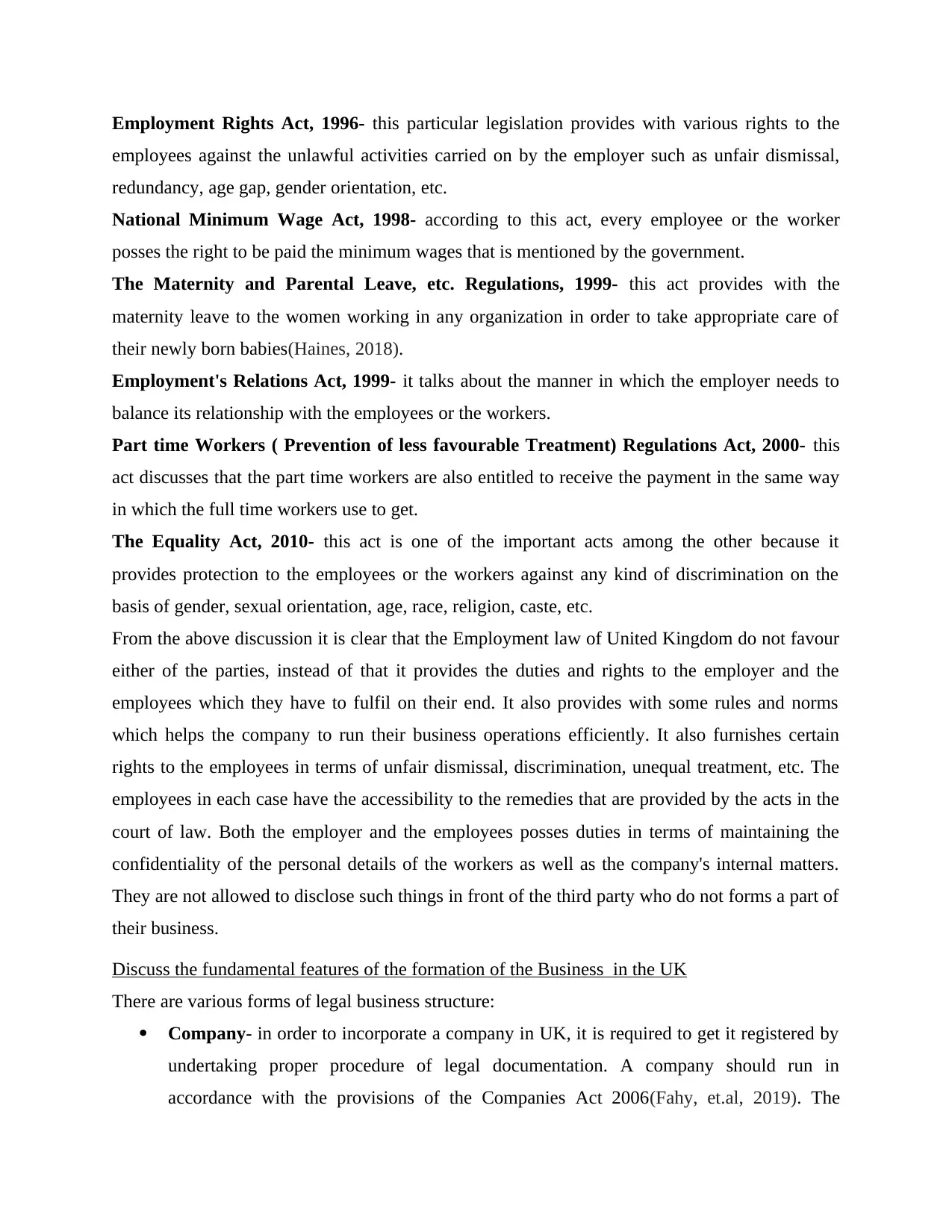
Employment Rights Act, 1996- this particular legislation provides with various rights to the
employees against the unlawful activities carried on by the employer such as unfair dismissal,
redundancy, age gap, gender orientation, etc.
National Minimum Wage Act, 1998- according to this act, every employee or the worker
posses the right to be paid the minimum wages that is mentioned by the government.
The Maternity and Parental Leave, etc. Regulations, 1999- this act provides with the
maternity leave to the women working in any organization in order to take appropriate care of
their newly born babies(Haines, 2018).
Employment's Relations Act, 1999- it talks about the manner in which the employer needs to
balance its relationship with the employees or the workers.
Part time Workers ( Prevention of less favourable Treatment) Regulations Act, 2000- this
act discusses that the part time workers are also entitled to receive the payment in the same way
in which the full time workers use to get.
The Equality Act, 2010- this act is one of the important acts among the other because it
provides protection to the employees or the workers against any kind of discrimination on the
basis of gender, sexual orientation, age, race, religion, caste, etc.
From the above discussion it is clear that the Employment law of United Kingdom do not favour
either of the parties, instead of that it provides the duties and rights to the employer and the
employees which they have to fulfil on their end. It also provides with some rules and norms
which helps the company to run their business operations efficiently. It also furnishes certain
rights to the employees in terms of unfair dismissal, discrimination, unequal treatment, etc. The
employees in each case have the accessibility to the remedies that are provided by the acts in the
court of law. Both the employer and the employees posses duties in terms of maintaining the
confidentiality of the personal details of the workers as well as the company's internal matters.
They are not allowed to disclose such things in front of the third party who do not forms a part of
their business.
Discuss the fundamental features of the formation of the Business in the UK
There are various forms of legal business structure:
Company- in order to incorporate a company in UK, it is required to get it registered by
undertaking proper procedure of legal documentation. A company should run in
accordance with the provisions of the Companies Act 2006(Fahy, et.al, 2019). The
employees against the unlawful activities carried on by the employer such as unfair dismissal,
redundancy, age gap, gender orientation, etc.
National Minimum Wage Act, 1998- according to this act, every employee or the worker
posses the right to be paid the minimum wages that is mentioned by the government.
The Maternity and Parental Leave, etc. Regulations, 1999- this act provides with the
maternity leave to the women working in any organization in order to take appropriate care of
their newly born babies(Haines, 2018).
Employment's Relations Act, 1999- it talks about the manner in which the employer needs to
balance its relationship with the employees or the workers.
Part time Workers ( Prevention of less favourable Treatment) Regulations Act, 2000- this
act discusses that the part time workers are also entitled to receive the payment in the same way
in which the full time workers use to get.
The Equality Act, 2010- this act is one of the important acts among the other because it
provides protection to the employees or the workers against any kind of discrimination on the
basis of gender, sexual orientation, age, race, religion, caste, etc.
From the above discussion it is clear that the Employment law of United Kingdom do not favour
either of the parties, instead of that it provides the duties and rights to the employer and the
employees which they have to fulfil on their end. It also provides with some rules and norms
which helps the company to run their business operations efficiently. It also furnishes certain
rights to the employees in terms of unfair dismissal, discrimination, unequal treatment, etc. The
employees in each case have the accessibility to the remedies that are provided by the acts in the
court of law. Both the employer and the employees posses duties in terms of maintaining the
confidentiality of the personal details of the workers as well as the company's internal matters.
They are not allowed to disclose such things in front of the third party who do not forms a part of
their business.
Discuss the fundamental features of the formation of the Business in the UK
There are various forms of legal business structure:
Company- in order to incorporate a company in UK, it is required to get it registered by
undertaking proper procedure of legal documentation. A company should run in
accordance with the provisions of the Companies Act 2006(Fahy, et.al, 2019). The
Paraphrase This Document
Need a fresh take? Get an instant paraphrase of this document with our AI Paraphraser
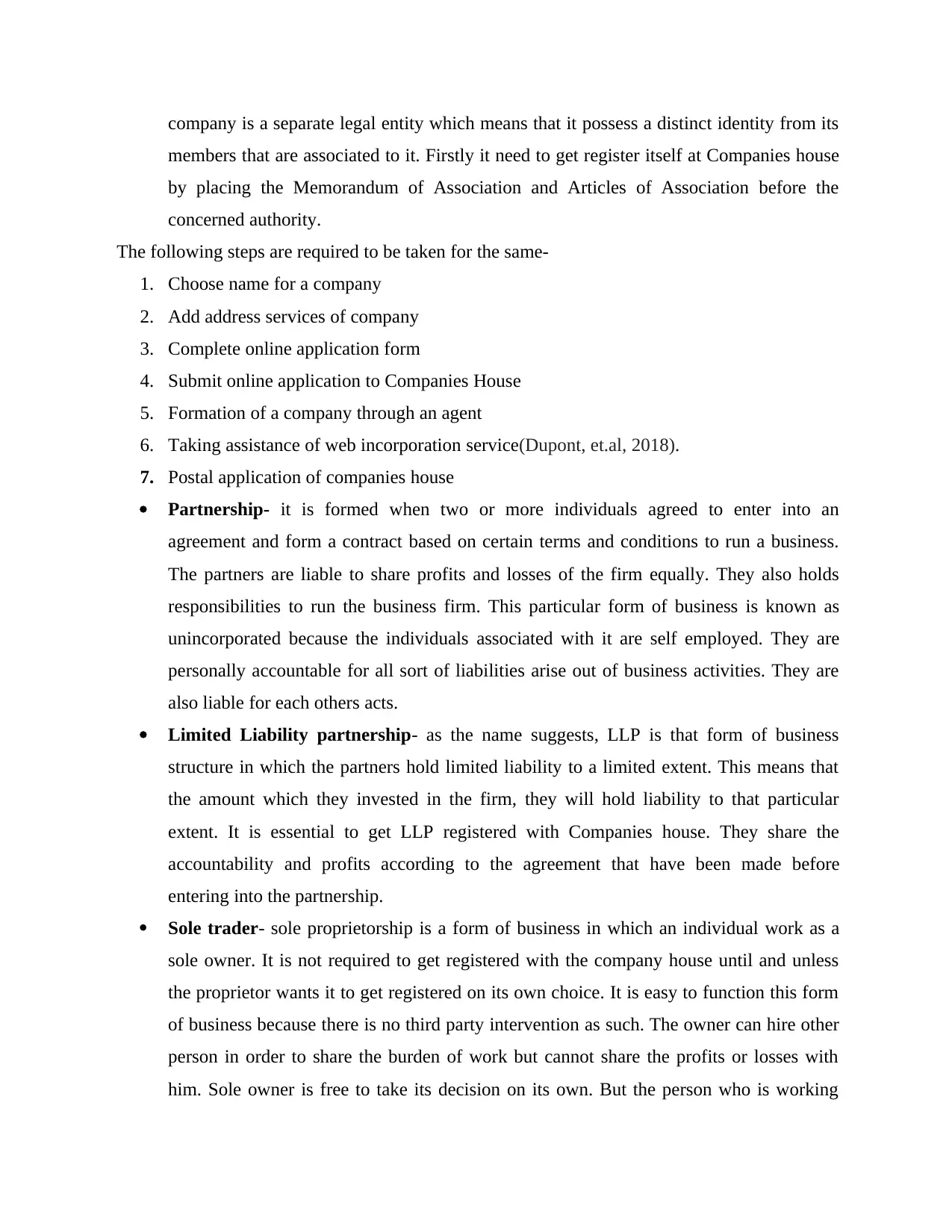
company is a separate legal entity which means that it possess a distinct identity from its
members that are associated to it. Firstly it need to get register itself at Companies house
by placing the Memorandum of Association and Articles of Association before the
concerned authority.
The following steps are required to be taken for the same-
1. Choose name for a company
2. Add address services of company
3. Complete online application form
4. Submit online application to Companies House
5. Formation of a company through an agent
6. Taking assistance of web incorporation service(Dupont, et.al, 2018).
7. Postal application of companies house
Partnership- it is formed when two or more individuals agreed to enter into an
agreement and form a contract based on certain terms and conditions to run a business.
The partners are liable to share profits and losses of the firm equally. They also holds
responsibilities to run the business firm. This particular form of business is known as
unincorporated because the individuals associated with it are self employed. They are
personally accountable for all sort of liabilities arise out of business activities. They are
also liable for each others acts.
Limited Liability partnership- as the name suggests, LLP is that form of business
structure in which the partners hold limited liability to a limited extent. This means that
the amount which they invested in the firm, they will hold liability to that particular
extent. It is essential to get LLP registered with Companies house. They share the
accountability and profits according to the agreement that have been made before
entering into the partnership.
Sole trader- sole proprietorship is a form of business in which an individual work as a
sole owner. It is not required to get registered with the company house until and unless
the proprietor wants it to get registered on its own choice. It is easy to function this form
of business because there is no third party intervention as such. The owner can hire other
person in order to share the burden of work but cannot share the profits or losses with
him. Sole owner is free to take its decision on its own. But the person who is working
members that are associated to it. Firstly it need to get register itself at Companies house
by placing the Memorandum of Association and Articles of Association before the
concerned authority.
The following steps are required to be taken for the same-
1. Choose name for a company
2. Add address services of company
3. Complete online application form
4. Submit online application to Companies House
5. Formation of a company through an agent
6. Taking assistance of web incorporation service(Dupont, et.al, 2018).
7. Postal application of companies house
Partnership- it is formed when two or more individuals agreed to enter into an
agreement and form a contract based on certain terms and conditions to run a business.
The partners are liable to share profits and losses of the firm equally. They also holds
responsibilities to run the business firm. This particular form of business is known as
unincorporated because the individuals associated with it are self employed. They are
personally accountable for all sort of liabilities arise out of business activities. They are
also liable for each others acts.
Limited Liability partnership- as the name suggests, LLP is that form of business
structure in which the partners hold limited liability to a limited extent. This means that
the amount which they invested in the firm, they will hold liability to that particular
extent. It is essential to get LLP registered with Companies house. They share the
accountability and profits according to the agreement that have been made before
entering into the partnership.
Sole trader- sole proprietorship is a form of business in which an individual work as a
sole owner. It is not required to get registered with the company house until and unless
the proprietor wants it to get registered on its own choice. It is easy to function this form
of business because there is no third party intervention as such. The owner can hire other
person in order to share the burden of work but cannot share the profits or losses with
him. Sole owner is free to take its decision on its own. But the person who is working
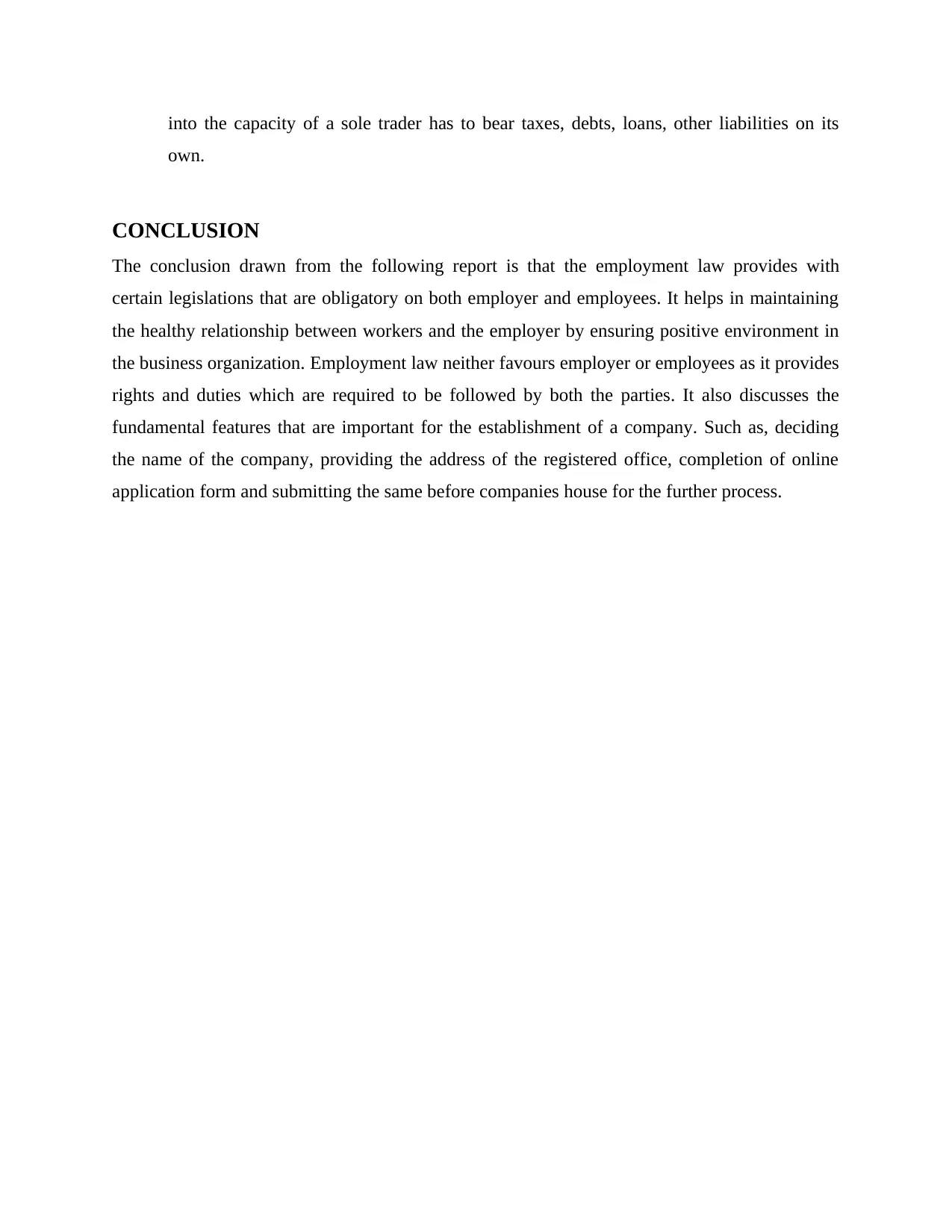
into the capacity of a sole trader has to bear taxes, debts, loans, other liabilities on its
own.
CONCLUSION
The conclusion drawn from the following report is that the employment law provides with
certain legislations that are obligatory on both employer and employees. It helps in maintaining
the healthy relationship between workers and the employer by ensuring positive environment in
the business organization. Employment law neither favours employer or employees as it provides
rights and duties which are required to be followed by both the parties. It also discusses the
fundamental features that are important for the establishment of a company. Such as, deciding
the name of the company, providing the address of the registered office, completion of online
application form and submitting the same before companies house for the further process.
own.
CONCLUSION
The conclusion drawn from the following report is that the employment law provides with
certain legislations that are obligatory on both employer and employees. It helps in maintaining
the healthy relationship between workers and the employer by ensuring positive environment in
the business organization. Employment law neither favours employer or employees as it provides
rights and duties which are required to be followed by both the parties. It also discusses the
fundamental features that are important for the establishment of a company. Such as, deciding
the name of the company, providing the address of the registered office, completion of online
application form and submitting the same before companies house for the further process.
⊘ This is a preview!⊘
Do you want full access?
Subscribe today to unlock all pages.

Trusted by 1+ million students worldwide
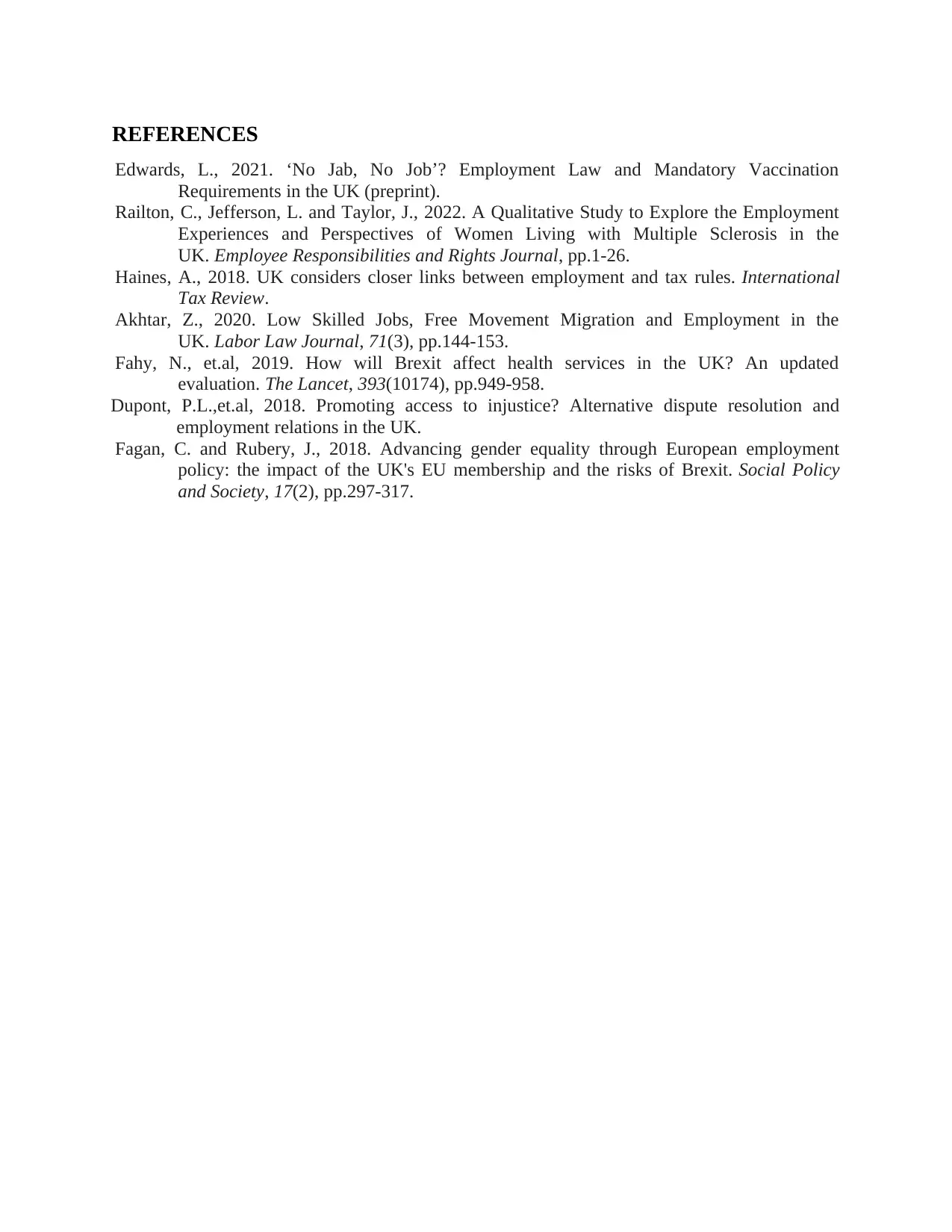
REFERENCES
Edwards, L., 2021. ‘No Jab, No Job’? Employment Law and Mandatory Vaccination
Requirements in the UK (preprint).
Railton, C., Jefferson, L. and Taylor, J., 2022. A Qualitative Study to Explore the Employment
Experiences and Perspectives of Women Living with Multiple Sclerosis in the
UK. Employee Responsibilities and Rights Journal, pp.1-26.
Haines, A., 2018. UK considers closer links between employment and tax rules. International
Tax Review.
Akhtar, Z., 2020. Low Skilled Jobs, Free Movement Migration and Employment in the
UK. Labor Law Journal, 71(3), pp.144-153.
Fahy, N., et.al, 2019. How will Brexit affect health services in the UK? An updated
evaluation. The Lancet, 393(10174), pp.949-958.
Dupont, P.L.,et.al, 2018. Promoting access to injustice? Alternative dispute resolution and
employment relations in the UK.
Fagan, C. and Rubery, J., 2018. Advancing gender equality through European employment
policy: the impact of the UK's EU membership and the risks of Brexit. Social Policy
and Society, 17(2), pp.297-317.
Edwards, L., 2021. ‘No Jab, No Job’? Employment Law and Mandatory Vaccination
Requirements in the UK (preprint).
Railton, C., Jefferson, L. and Taylor, J., 2022. A Qualitative Study to Explore the Employment
Experiences and Perspectives of Women Living with Multiple Sclerosis in the
UK. Employee Responsibilities and Rights Journal, pp.1-26.
Haines, A., 2018. UK considers closer links between employment and tax rules. International
Tax Review.
Akhtar, Z., 2020. Low Skilled Jobs, Free Movement Migration and Employment in the
UK. Labor Law Journal, 71(3), pp.144-153.
Fahy, N., et.al, 2019. How will Brexit affect health services in the UK? An updated
evaluation. The Lancet, 393(10174), pp.949-958.
Dupont, P.L.,et.al, 2018. Promoting access to injustice? Alternative dispute resolution and
employment relations in the UK.
Fagan, C. and Rubery, J., 2018. Advancing gender equality through European employment
policy: the impact of the UK's EU membership and the risks of Brexit. Social Policy
and Society, 17(2), pp.297-317.
1 out of 7
Related Documents
Your All-in-One AI-Powered Toolkit for Academic Success.
+13062052269
info@desklib.com
Available 24*7 on WhatsApp / Email
![[object Object]](/_next/static/media/star-bottom.7253800d.svg)
Unlock your academic potential
Copyright © 2020–2025 A2Z Services. All Rights Reserved. Developed and managed by ZUCOL.





